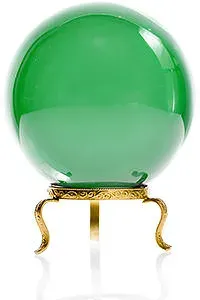 The
The ![]() emerald was used as a crystal ball, allowing its wearer to see the future. That would only work if it were placed under the person's tongue. It is unclear if one would be able to gaze inside the emerald itself and foresee the future, or if one would be able to see the future by just wearing emerald jewelry. Other benefits of wearing emerald included enhancing one's memory, becoming a more eloquent speaker, and deciphering whether a lover's promise was honest and true. It is worth noting that it was believed that emerald did not embrace sexual passion. According to one legend, when King Bela of Hungary hugged his wife while wearing a very large and valuableemerald, it cracked and broke into three pieces.
emerald was used as a crystal ball, allowing its wearer to see the future. That would only work if it were placed under the person's tongue. It is unclear if one would be able to gaze inside the emerald itself and foresee the future, or if one would be able to see the future by just wearing emerald jewelry. Other benefits of wearing emerald included enhancing one's memory, becoming a more eloquent speaker, and deciphering whether a lover's promise was honest and true. It is worth noting that it was believed that emerald did not embrace sexual passion. According to one legend, when King Bela of Hungary hugged his wife while wearing a very large and valuableemerald, it cracked and broke into three pieces.
 Rabbinical legends tell us that G-d gave King Solomon four precious gemstones to make his a wise ruler. They were most likely red, yellow, blue and green, with green being the
Rabbinical legends tell us that G-d gave King Solomon four precious gemstones to make his a wise ruler. They were most likely red, yellow, blue and green, with green being the ![]() emerald and others being carbuncle,
emerald and others being carbuncle, ![]() lapis lazuli, and
lapis lazuli, and ![]() topaz. It was also believed that emerald "sharpens wit and quickens the intelligence"" even going as far as suggesting that it may make people rich."
topaz. It was also believed that emerald "sharpens wit and quickens the intelligence"" even going as far as suggesting that it may make people rich."
 One talismanic
One talismanic ![]() emerald weighing 78 karats was recently found and shown in Europe. It belonged to the Mogul emperors of Delhi. Inside was the following inscription in Persian characters, "He who possesses this charm, shall enjoy the special protection of G-d""."
emerald weighing 78 karats was recently found and shown in Europe. It belonged to the Mogul emperors of Delhi. Inside was the following inscription in Persian characters, "He who possesses this charm, shall enjoy the special protection of G-d""."
 Gypsum is cheap and soft and can be cut with a fingernail. It is known for its cat's eye effect. It is usually cut rounded, or "en cabochon"" to allow its long natural fibers, known as ""satin spar"" to shine through. Sometimes it is cut in pear-shaped drops or beads. It is usually found in England and Russia and is set into earrings, pins, necklaces and even ornaments. The Russian gypsum is golden yellow or peach in color, and if cut into an egg shape makes a great gift for Easter. It is believed to grant protection to its wearer and bring good fortune."
Gypsum is cheap and soft and can be cut with a fingernail. It is known for its cat's eye effect. It is usually cut rounded, or "en cabochon"" to allow its long natural fibers, known as ""satin spar"" to shine through. Sometimes it is cut in pear-shaped drops or beads. It is usually found in England and Russia and is set into earrings, pins, necklaces and even ornaments. The Russian gypsum is golden yellow or peach in color, and if cut into an egg shape makes a great gift for Easter. It is believed to grant protection to its wearer and bring good fortune."
 Gypsum is often mounted in brass and sold as "luck stones"" at Niagara, claiming that it was taken from beneath the Falls with great danger. (It's true that gypsum may occasionally be found in the Falls). The Japanese value gypsum for its purity, or possibly because they like its cat's eye look. In Egypt, gypsum ornaments that are cut into oval shape are known as ""Pharaoh's eggs."""
Gypsum is often mounted in brass and sold as "luck stones"" at Niagara, claiming that it was taken from beneath the Falls with great danger. (It's true that gypsum may occasionally be found in the Falls). The Japanese value gypsum for its purity, or possibly because they like its cat's eye look. In Egypt, gypsum ornaments that are cut into oval shape are known as ""Pharaoh's eggs."""
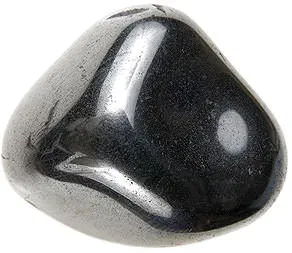 Hematite is a red oxide of iron that shows red streaks if scratched. It is derived from Greek "Haima"", which means blood. It was believed to bestow upon its wearer a favorable judgment outcome in court. Due to its blood red color, hematite is associated with Mars, the god of war, and is believed to offer warriors invulnerability if they rubbed their bodies with it."
Hematite is a red oxide of iron that shows red streaks if scratched. It is derived from Greek "Haima"", which means blood. It was believed to bestow upon its wearer a favorable judgment outcome in court. Due to its blood red color, hematite is associated with Mars, the god of war, and is believed to offer warriors invulnerability if they rubbed their bodies with it."
 Jacinth is a gemstone that was often used as an amulet for travelers, as it protected against injuries obtained during travel and prevented diseases. It is said that the stone would lose its luster if its wearer or anyone in the vicinity would fall ill of a plague. Even if the disease were all around, its wearer would miraculously stay safe. If a person became enchanted by a spell, he would be advised to bake a loaf of bread and pass jacinth through the cut in the crust, reciting these words: "May G-d who cast away all precious stones from the devil ï¾… cast away from thee, all phantoms and all magic spells, and free thee from the pain of this madness"". He was then instructed to eat this bread and recite these words over all other solid foods as well."
Jacinth is a gemstone that was often used as an amulet for travelers, as it protected against injuries obtained during travel and prevented diseases. It is said that the stone would lose its luster if its wearer or anyone in the vicinity would fall ill of a plague. Even if the disease were all around, its wearer would miraculously stay safe. If a person became enchanted by a spell, he would be advised to bake a loaf of bread and pass jacinth through the cut in the crust, reciting these words: "May G-d who cast away all precious stones from the devil ï¾… cast away from thee, all phantoms and all magic spells, and free thee from the pain of this madness"". He was then instructed to eat this bread and recite these words over all other solid foods as well."
 It was also believed to ensure a warm welcome at any inn one would visit or stay at during his travels. In addition, jacinth would increase its owner's wealth, give him the wisdom to manage his affairs properly, and induce sleep. And of course, that would only work best if the stone was of the best quality, with a bright red hue.
It was also believed to ensure a warm welcome at any inn one would visit or stay at during his travels. In addition, jacinth would increase its owner's wealth, give him the wisdom to manage his affairs properly, and induce sleep. And of course, that would only work best if the stone was of the best quality, with a bright red hue.
 Moreover, jacinth was believed to protect its wearer against lightning. It was reported that no one that ever wore jacinth during lightning was harmed. Even if the person only had the wax that was imprinted on the Jacinth with him, but not the stone itself, it would still protect him against lightning.
Moreover, jacinth was believed to protect its wearer against lightning. It was reported that no one that ever wore jacinth during lightning was harmed. Even if the person only had the wax that was imprinted on the Jacinth with him, but not the stone itself, it would still protect him against lightning.
 Jade refers to two different minerals, Nephrite and Jadeite. Nephrite is a silicate of magnesia with an exceptionally tough structure and a 6.5 rank on the Moh's hardness scale. Jadeite is a silicate of alumina, is more crystalline than Nephrite and not as tough. It ranks a 7 on the Moh's scale. The rich green variety of
Jade refers to two different minerals, Nephrite and Jadeite. Nephrite is a silicate of magnesia with an exceptionally tough structure and a 6.5 rank on the Moh's hardness scale. Jadeite is a silicate of alumina, is more crystalline than Nephrite and not as tough. It ranks a 7 on the Moh's scale. The rich green variety of ![]() jade is called Imperial Jade, "Kingfisher plumes"", and ""feitsui"" by the Chinese."
jade is called Imperial Jade, "Kingfisher plumes"", and ""feitsui"" by the Chinese."
 The ancient Chinese have been collecting and using
The ancient Chinese have been collecting and using ![]() jade for personal decoration for centuries. The original Chinese character "pao"", which means, ""precious,"" consists of a picture of a house with jade beads, shells and an earthen jar. Jade beads symbolize the oldest form of a Chinese ideograph for ""King"", and is still used in China as an emblem of high rank, power, and authority."
jade for personal decoration for centuries. The original Chinese character "pao"", which means, ""precious,"" consists of a picture of a house with jade beads, shells and an earthen jar. Jade beads symbolize the oldest form of a Chinese ideograph for ""King"", and is still used in China as an emblem of high rank, power, and authority."
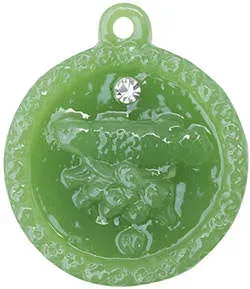 The Chinese place high value on
The Chinese place high value on ![]() jade amulets, calling them "concentrated essence of love."" They believe that carrying pieces of jade with them is important because the secret essence of jade gets absorbed into the body. When jade is struck, it sounds a beautiful melodious note which resembles one that's in love. One amulet depicting two men is called ""The Brothers of Heavenly Love."" It is customarily given to friends. When young girls come of age, they may be given a phoenix made of jade as a popular amulet. When a couple gets married, they may receive a jade amulet of a man on a unicorn holding castanets. That represents the future birth of an heir. Babies may be given a jade amulet in a form of a padlock which would be worn around the infant's neck. It would protect the infant from childhood diseases and guarantee it a long, healthy life."
jade amulets, calling them "concentrated essence of love."" They believe that carrying pieces of jade with them is important because the secret essence of jade gets absorbed into the body. When jade is struck, it sounds a beautiful melodious note which resembles one that's in love. One amulet depicting two men is called ""The Brothers of Heavenly Love."" It is customarily given to friends. When young girls come of age, they may be given a phoenix made of jade as a popular amulet. When a couple gets married, they may receive a jade amulet of a man on a unicorn holding castanets. That represents the future birth of an heir. Babies may be given a jade amulet in a form of a padlock which would be worn around the infant's neck. It would protect the infant from childhood diseases and guarantee it a long, healthy life."
 According to the Chinese,
According to the Chinese, ![]() jade carries romantic significance. A butterfly carved out of jade is a powerful symbol of successful love and is often presented by grooms to their brides. According to a Chinese legend, one youth was busy chasing a colorful butterfly and suddenly found himself in a garden that belonged to a rich bureaucrat. But instead of being punished for trespassing, the youth ended up marrying the official's daughter. Jade is often used at a wedding feast. Both bride and groom drink from a special jade cup carved in a shape of a rooster. According to a legend, a beautiful white rooster witnessed his mistress drowning herself in a well after she lost her lover. The rooster was so attached to this young lady who frequently petted him, that he chose to throw himself into a well also and to die the same way out of solidarity with his mistress.
jade carries romantic significance. A butterfly carved out of jade is a powerful symbol of successful love and is often presented by grooms to their brides. According to a Chinese legend, one youth was busy chasing a colorful butterfly and suddenly found himself in a garden that belonged to a rich bureaucrat. But instead of being punished for trespassing, the youth ended up marrying the official's daughter. Jade is often used at a wedding feast. Both bride and groom drink from a special jade cup carved in a shape of a rooster. According to a legend, a beautiful white rooster witnessed his mistress drowning herself in a well after she lost her lover. The rooster was so attached to this young lady who frequently petted him, that he chose to throw himself into a well also and to die the same way out of solidarity with his mistress.
 The Woodward Collection is a fine collection of various Chinese
The Woodward Collection is a fine collection of various Chinese ![]() jade carvings, currently part of the Imperial Jade Works in Peking. One of the ornaments, a citron (lemon) with finger-like projections protruding from the fruit, was carved at the beginning of the 18th century. Named "the hand of Buddha"", it was carved from the rare feitsui, or Kingfisher-green jade, which is a deep
jade carvings, currently part of the Imperial Jade Works in Peking. One of the ornaments, a citron (lemon) with finger-like projections protruding from the fruit, was carved at the beginning of the 18th century. Named "the hand of Buddha"", it was carved from the rare feitsui, or Kingfisher-green jade, which is a deep ![]() emerald green jadeite with transparent green shading. It is a symbol of long life abundant with riches. A bat clinging to the fruit's foliage was added later, signifying an additional layer of good fortune. This is in stark contrast to the bat in Western mythology which is viewed extremely negatively."
emerald green jadeite with transparent green shading. It is a symbol of long life abundant with riches. A bat clinging to the fruit's foliage was added later, signifying an additional layer of good fortune. This is in stark contrast to the bat in Western mythology which is viewed extremely negatively."
 The ancient Egyptians had a custom of placing
The ancient Egyptians had a custom of placing ![]() jade, or some other green gemstone, in the mouth of a mummy and calling it his heart, as written in the Egyptian "Book of the Dead."" The ancient Mexicans had a similar custom as well, since, in their language, the literal meaning of a ""free man"" was ""fresh"" or ""green-hearted"". Jade was considered valuable in their culture, and being buried with Jade alluded to a high rank. In fact, the chief would cut off a piece of his own jade stone that he wore to bury his tribesman with it. The Chinese also buried their dead with jade in their mouths, believing it to offer protection to the dead. It was even called ""tomb jades"" or ""mouth jades."" The Metropolitan Museum of Art in NYC has a 279 piece collection of these ""mouth jades"" that were collected from Chinese tombs on display."
jade, or some other green gemstone, in the mouth of a mummy and calling it his heart, as written in the Egyptian "Book of the Dead."" The ancient Mexicans had a similar custom as well, since, in their language, the literal meaning of a ""free man"" was ""fresh"" or ""green-hearted"". Jade was considered valuable in their culture, and being buried with Jade alluded to a high rank. In fact, the chief would cut off a piece of his own jade stone that he wore to bury his tribesman with it. The Chinese also buried their dead with jade in their mouths, believing it to offer protection to the dead. It was even called ""tomb jades"" or ""mouth jades."" The Metropolitan Museum of Art in NYC has a 279 piece collection of these ""mouth jades"" that were collected from Chinese tombs on display."
 Known as a "gem par excellence,""
Known as a "gem par excellence,"" ![]() jade was long used to made music by the ancient Chinese. They would make a ""stone chime"" out of 16 pieces of undecorated jade for use in court and religious ceremonies. Another kind of instrument called the ""singers' chime,"" consisted of 12 to 24 Jade pieces that were carved into intricate shapes. Legend has it that when Confucius felt particularly troubled by his inability to reform the Chinese morals, he would take solace by playing on his ""musical stone"" made from jade."
jade was long used to made music by the ancient Chinese. They would make a ""stone chime"" out of 16 pieces of undecorated jade for use in court and religious ceremonies. Another kind of instrument called the ""singers' chime,"" consisted of 12 to 24 Jade pieces that were carved into intricate shapes. Legend has it that when Confucius felt particularly troubled by his inability to reform the Chinese morals, he would take solace by playing on his ""musical stone"" made from jade."
 The Maoris of New Zealand referred to Jade as "punamu,"" or green stone. It was so rare and valuable that a magician, or ""tohunga,"" was summoned to help
The Maoris of New Zealand referred to Jade as "punamu,"" or green stone. It was so rare and valuable that a magician, or ""tohunga,"" was summoned to help ![]() jade seekers learn of its location. Once a general area was reached, the ""tohunga"" would meditate in isolation and then exclaim that a spirit of a person, dead or alive, appeared before him and directed him to the exact location where jade was to be found. (The magician would learn of the jade whereabouts beforehand). The excavated jade would then be carved into an image of the human spirit that appeared before the ""tohunga"" to thank him for helping the group locate this valuable gemstone. This carved ornament was known as a ""hei-tiki."""
jade seekers learn of its location. Once a general area was reached, the ""tohunga"" would meditate in isolation and then exclaim that a spirit of a person, dead or alive, appeared before him and directed him to the exact location where jade was to be found. (The magician would learn of the jade whereabouts beforehand). The excavated jade would then be carved into an image of the human spirit that appeared before the ""tohunga"" to thank him for helping the group locate this valuable gemstone. This carved ornament was known as a ""hei-tiki."""
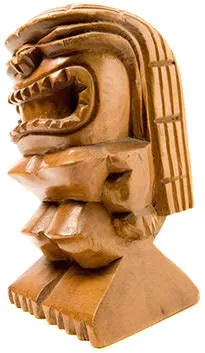 "Hei-tikis"" consisted of distorted human faces, often with enlarged or grotesque features, which represented the spirit that helped find the
"Hei-tikis"" consisted of distorted human faces, often with enlarged or grotesque features, which represented the spirit that helped find the ![]() jade stone in the first place. These ""hei-tikis"" served as memorials and were passed down from generation to generation as a valuable heirloom. It was believed that they contained hidden messages from the family's ancestor. When the head of the household died, he would be buried with his ""hei-tiki."" And later, the ""hei-tiki"" would be dug up by the nearest male relative and worn until he died. If the wearer were the last male in his family, then no one would dig it up, and so it would stay with his family forever. Many tribal and intertribal feuds arose due to possession of the ""hei-tikis,"" signifying their importance. Most ""hei-tikis"" that were collected today seem to be crafted one hundred to one hundred and fifty years ago."
jade stone in the first place. These ""hei-tikis"" served as memorials and were passed down from generation to generation as a valuable heirloom. It was believed that they contained hidden messages from the family's ancestor. When the head of the household died, he would be buried with his ""hei-tiki."" And later, the ""hei-tiki"" would be dug up by the nearest male relative and worn until he died. If the wearer were the last male in his family, then no one would dig it up, and so it would stay with his family forever. Many tribal and intertribal feuds arose due to possession of the ""hei-tikis,"" signifying their importance. Most ""hei-tikis"" that were collected today seem to be crafted one hundred to one hundred and fifty years ago."
 The green variety of
The green variety of ![]() jasper is reminiscent of the greenery of the fields, even more so than the
jasper is reminiscent of the greenery of the fields, even more so than the ![]() emerald. It is therefore known as the "rain bringer."" Its other attributes include chasing away evil spirits and offering protection from bites of venomous creatures. An anonymous German author of the 11th or 12th century explains that jasper had an amazing quality to attract snake poison to itself, so when placed directly over the bite, it would heal the victim."
emerald. It is therefore known as the "rain bringer."" Its other attributes include chasing away evil spirits and offering protection from bites of venomous creatures. An anonymous German author of the 11th or 12th century explains that jasper had an amazing quality to attract snake poison to itself, so when placed directly over the bite, it would heal the victim."
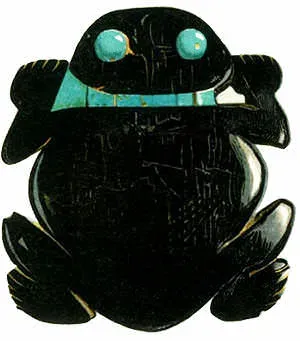 Jet was a popular gemstone used as amulets by the Pueblo Indians. An intricately designed frog crafted out of Jet was discovered in Pueblo Bonito in 1896. It was exceptionally well made, with
Jet was a popular gemstone used as amulets by the Pueblo Indians. An intricately designed frog crafted out of Jet was discovered in Pueblo Bonito in 1896. It was exceptionally well made, with ![]() turquoise eyes and a band or turquoise around its neck. This shows the importance of Jet among the Pueblo Indians since none of the other amulets found in that region at that time possessed such skilled handiwork.
Jet has also been discovered in Paleolithic remains in the caves of Belgium and Switzerland. It also strongly suggested the use of Jet as talismans, since the jet pieces were crafted as circles with holes in the middle, signifying its use in necklaces and pendants. Jewelry was often used as amulets because it came in close contact with the skin, endowing its wearer with special powers. Jet, in particular, was believed to become part of the body and soul of the wearer, and special care was necessary to protect it from being lost or stolen.
turquoise eyes and a band or turquoise around its neck. This shows the importance of Jet among the Pueblo Indians since none of the other amulets found in that region at that time possessed such skilled handiwork.
Jet has also been discovered in Paleolithic remains in the caves of Belgium and Switzerland. It also strongly suggested the use of Jet as talismans, since the jet pieces were crafted as circles with holes in the middle, signifying its use in necklaces and pendants. Jewelry was often used as amulets because it came in close contact with the skin, endowing its wearer with special powers. Jet, in particular, was believed to become part of the body and soul of the wearer, and special care was necessary to protect it from being lost or stolen.
 This blue gemstone with "small golden spots"" was intensely popular in the ancient culture of Babylon and Egypt. The Assyrian moon god Sin was poetically described as ""bright as the Lapis Lazuli."" It was believed to cure depression and ""quartern fever,"" which is a fever that returns every 3rd or 4th day."
This blue gemstone with "small golden spots"" was intensely popular in the ancient culture of Babylon and Egypt. The Assyrian moon god Sin was poetically described as ""bright as the Lapis Lazuli."" It was believed to cure depression and ""quartern fever,"" which is a fever that returns every 3rd or 4th day."
 Loadstone, more commonly known as "the Heraclean stone"", is another popular gemstone found in Greek and Roman literature. Plato, the ancient Greek philosopher, citing the works of a Greek poet Euripides, attributes to loadstone amazing magnetic qualities. Pliny, the Roman author and philosopher, offers a legend of a shepherd named Magnes, who discovered loadstone on Mt. Ida because it clung to the nails in his shoes while he was tending his flock."
Loadstone, more commonly known as "the Heraclean stone"", is another popular gemstone found in Greek and Roman literature. Plato, the ancient Greek philosopher, citing the works of a Greek poet Euripides, attributes to loadstone amazing magnetic qualities. Pliny, the Roman author and philosopher, offers a legend of a shepherd named Magnes, who discovered loadstone on Mt. Ida because it clung to the nails in his shoes while he was tending his flock."
 Loadstone's magnetic qualities were well known among the architects of the Roman period. Pliny the Philosopher recounts a story of how Ptolemy Philadelphus (309-247 BCE) attempted to build an iron statue in honor of his sister and wife Arsinoe. He wanted the statue to be suspended in air with the help of loadstone magnets, which were to be hidden in the floor and roof of the temple. However, the Egyptian architect Chirocrates from Alexandria, who was commissioned to build this statue, died before the work was completed.
Loadstone's magnetic qualities were well known among the architects of the Roman period. Pliny the Philosopher recounts a story of how Ptolemy Philadelphus (309-247 BCE) attempted to build an iron statue in honor of his sister and wife Arsinoe. He wanted the statue to be suspended in air with the help of loadstone magnets, which were to be hidden in the floor and roof of the temple. However, the Egyptian architect Chirocrates from Alexandria, who was commissioned to build this statue, died before the work was completed.
 The Roman poet Claudian (5th century AD) describes how the priests of a certain temple decided to make a fantastic spectacle to draw in a large crowd. They ordered two statues to be built, one representing Mars, built out of iron, and the other representing Venus, built out of loadstone. At the festival, the two statues were moved close to each other and everyone witnessed how Venus literally drew Mars to her due to the power of magnetism.
The Roman poet Claudian (5th century AD) describes how the priests of a certain temple decided to make a fantastic spectacle to draw in a large crowd. They ordered two statues to be built, one representing Mars, built out of iron, and the other representing Venus, built out of loadstone. At the festival, the two statues were moved close to each other and everyone witnessed how Venus literally drew Mars to her due to the power of magnetism.
 In the early 4th century, there was a belief that loadstone placed under the pillow of a sleeping wife would act as a benchmark to her virtue, as described by an Alexandrian poem "Lithica"". The same writer went on to describe that if powdered loadstone was mixed with coals and thrown in the four corners of the house, one would feel that the house was coming down."
In the early 4th century, there was a belief that loadstone placed under the pillow of a sleeping wife would act as a benchmark to her virtue, as described by an Alexandrian poem "Lithica"". The same writer went on to describe that if powdered loadstone was mixed with coals and thrown in the four corners of the house, one would feel that the house was coming down."
 Even the word for loadstone, in several languages, refers to its effect of attraction, or drawing one in. In Low Latin, loadstone is sometimes called "Adamas,"" which means ""to love"", although some attribute that word to
Even the word for loadstone, in several languages, refers to its effect of attraction, or drawing one in. In Low Latin, loadstone is sometimes called "Adamas,"" which means ""to love"", although some attribute that word to ![]() diamond. In Sanskrit, it is called ""chumbaka"", which means ""the kisser"", and in Chinese, it is the ""t' su shi,"" or ""the loving stone."" Chin T'sang Khi, an 8th century Chinese author, writes that ""the loadstone attracts iron just as does a tender mother when she calls her children to her."""
diamond. In Sanskrit, it is called ""chumbaka"", which means ""the kisser"", and in Chinese, it is the ""t' su shi,"" or ""the loving stone."" Chin T'sang Khi, an 8th century Chinese author, writes that ""the loadstone attracts iron just as does a tender mother when she calls her children to her."""
 Mohammedan legends recounting stories of conquests of Alexander the Great describe how Alexander would give his soldiers loadstone as the defense against the evil spirits and enchantments. Kings in the East Indies favored the use of loadstone at their coronations, believing its magnetism would attract power, goodwill, and gifts.
Mohammedan legends recounting stories of conquests of Alexander the Great describe how Alexander would give his soldiers loadstone as the defense against the evil spirits and enchantments. Kings in the East Indies favored the use of loadstone at their coronations, believing its magnetism would attract power, goodwill, and gifts.
 This belief was prevalent even on our own continent in the 1800's. Loadstone is abundant in Magnet Cove, Arkansas, and it is estimated that 1 to 3 tons of it was annually sold to African Americans as conjuring stones for voodoo ceremonies. An interesting court case occurred in Macon, Georgia, in 1887. An African American woman brought a conjuror to court to recover the five dollars she spent on a piece of loadstone she purchased as an amulet to bring back her wandering husband. Since the market value of the gemstone was only 75 cents per pound, and she bought only a few ounces of loadstone, the judge ruled in her favor, ordering the conjuror to pay the woman back the full five dollars.
This belief was prevalent even on our own continent in the 1800's. Loadstone is abundant in Magnet Cove, Arkansas, and it is estimated that 1 to 3 tons of it was annually sold to African Americans as conjuring stones for voodoo ceremonies. An interesting court case occurred in Macon, Georgia, in 1887. An African American woman brought a conjuror to court to recover the five dollars she spent on a piece of loadstone she purchased as an amulet to bring back her wandering husband. Since the market value of the gemstone was only 75 cents per pound, and she bought only a few ounces of loadstone, the judge ruled in her favor, ordering the conjuror to pay the woman back the full five dollars.
 Malachite, for some unknown reasons, was used as a talisman specifically for children. It was believed to guard babies against evil spirits, and if malachite were attached to an infant's cradle, it would encourage deep, peaceful sleep. The sun, as the ultimate source of light, was the most common design to be engraved on malachite amulets. Since malachite was thought to protect against necromancers, witches, and demons that thrive in the darkness, the sun served as the perfect power to drive them away.
Malachite, for some unknown reasons, was used as a talisman specifically for children. It was believed to guard babies against evil spirits, and if malachite were attached to an infant's cradle, it would encourage deep, peaceful sleep. The sun, as the ultimate source of light, was the most common design to be engraved on malachite amulets. Since malachite was thought to protect against necromancers, witches, and demons that thrive in the darkness, the sun served as the perfect power to drive them away.
 Malachite's protective power was well known to the ancient Egyptians, as there's evidence of malachite mines constructed between Suez and Sinai as early as 4000 BCE. In some parts of Germany, malachite was fashioned together with
Malachite's protective power was well known to the ancient Egyptians, as there's evidence of malachite mines constructed between Suez and Sinai as early as 4000 BCE. In some parts of Germany, malachite was fashioned together with ![]() turquoise into amulets which would protect the wearer from the danger of falling. It would also signify the approaching disaster by shattering into many pieces.
turquoise into amulets which would protect the wearer from the danger of falling. It would also signify the approaching disaster by shattering into many pieces.
 The moonstone is considered a sacred stone in India and is believed to bring good luck to its wearer. It holds specific meaning for lovers, arousing passionate desire and offering the ability to see the future, but only if placed in the mouth during a full moon. When selling moonstone, it must be placed on a yellow cloth, since yellow is a sacred color in India.
The moonstone is considered a sacred stone in India and is believed to bring good luck to its wearer. It holds specific meaning for lovers, arousing passionate desire and offering the ability to see the future, but only if placed in the mouth during a full moon. When selling moonstone, it must be placed on a yellow cloth, since yellow is a sacred color in India.
 Antoine Mizauld (1510-1578), a French astronomer and physician, recounts the story of his friend, a great traveler, and owner of a moonstone. He describes that his moonstone had a white mark on it, which grew bigger and smaller much like the lunar phases of the moon. Not believing that this actually worked, Mizauld borrowed the moonstone from his friend and observed it for a month. The white mark was small at first, the size of a millet seed, and it appeared on the top. It later moved down to the middle of the stone and grew in size, assuming the round shape of the full moon. Then it gradually shrank in size and moved back up to the top of the moonstone, much like the moon in the sky. The owner of the stone dedicated it to the young King Edward IV, who favored rare and precious things.
Antoine Mizauld (1510-1578), a French astronomer and physician, recounts the story of his friend, a great traveler, and owner of a moonstone. He describes that his moonstone had a white mark on it, which grew bigger and smaller much like the lunar phases of the moon. Not believing that this actually worked, Mizauld borrowed the moonstone from his friend and observed it for a month. The white mark was small at first, the size of a millet seed, and it appeared on the top. It later moved down to the middle of the stone and grew in size, assuming the round shape of the full moon. Then it gradually shrank in size and moved back up to the top of the moonstone, much like the moon in the sky. The owner of the stone dedicated it to the young King Edward IV, who favored rare and precious things.
 According to Girolamo Cardano (1501-1576), Italian physician, mathematician, and philosopher, the
According to Girolamo Cardano (1501-1576), Italian physician, mathematician, and philosopher, the ![]() onyx was believed to promote discord and to separate lovers, especially when worn around the neck. This belief may have originated from the white lines that run along the stone's length or width, that contrast sharply with the blackness of onyx. In India, onyx jewelry was worn to calm lovers' passions.
onyx was believed to promote discord and to separate lovers, especially when worn around the neck. This belief may have originated from the white lines that run along the stone's length or width, that contrast sharply with the blackness of onyx. In India, onyx jewelry was worn to calm lovers' passions.
 Crystals of Iron Pyrite were sometimes used by Native Americans as amulets. Tribal medicine men would use various objects made out of pyrite for their incantations. Pyrite was sometimes called "fool's gold"" due to its glistening golden yellow color. The early Mexicans used to make mirrors out of pyrite, where one side would be polished flat, and the other would curve outward, with intricate carvings of symbolic images. One such pyrite mirror is now part of the Pinard collection in the Trocadero Museum in Paris."
Crystals of Iron Pyrite were sometimes used by Native Americans as amulets. Tribal medicine men would use various objects made out of pyrite for their incantations. Pyrite was sometimes called "fool's gold"" due to its glistening golden yellow color. The early Mexicans used to make mirrors out of pyrite, where one side would be polished flat, and the other would curve outward, with intricate carvings of symbolic images. One such pyrite mirror is now part of the Pinard collection in the Trocadero Museum in Paris."
 Rock Crystal is often found in mountain crevices and caverns, and according to Pliny, the Roman philosopher, it originated from water flowing in the caves and then thickening into rock crystal from being exposed to extreme cold temperature. Rock crystal is said to serve as a reminder to keep one safe from sin and to maintain crystal clear loyalty to the Church.
Rock Crystal is often found in mountain crevices and caverns, and according to Pliny, the Roman philosopher, it originated from water flowing in the caves and then thickening into rock crystal from being exposed to extreme cold temperature. Rock crystal is said to serve as a reminder to keep one safe from sin and to maintain crystal clear loyalty to the Church.
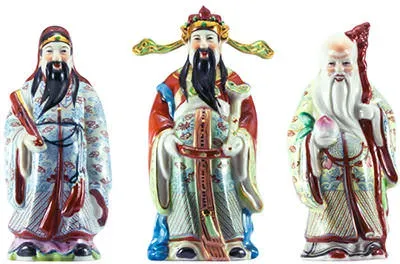 The Chinese Emperor Wu (156-87 BCE) erected many edifices to worship gods and other immortal spirits. The doors to all these buildings were built out of white rock crystal, bathing the interior in a stream of light. Although the Chinese texts call this substance rock crystal, it is possible that it was actually glass. One Chinese anecdote recounts a story of a wealthy bureaucrat named Muan Fen, who was afraid of drafts. When Muan Fen came to visit the Emperor, the doors of the chamber were tightly closed, but because they were made of rock crystal that was transparent, it looked like they were wide open and drafty. The Emperor started laughing when Muan Fen began to shake from being cold even though the temperature in the room was warm.
The Chinese Emperor Wu (156-87 BCE) erected many edifices to worship gods and other immortal spirits. The doors to all these buildings were built out of white rock crystal, bathing the interior in a stream of light. Although the Chinese texts call this substance rock crystal, it is possible that it was actually glass. One Chinese anecdote recounts a story of a wealthy bureaucrat named Muan Fen, who was afraid of drafts. When Muan Fen came to visit the Emperor, the doors of the chamber were tightly closed, but because they were made of rock crystal that was transparent, it looked like they were wide open and drafty. The Emperor started laughing when Muan Fen began to shake from being cold even though the temperature in the room was warm.
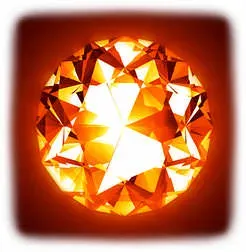 The fiery red color of
The fiery red color of ![]() ruby suggests that an inextinguishable flame once burned inside the stone. It was further believed that this fire could not be hidden and would shine through clothing or any material that may be used to cover the stone. If ruby came into contact with water, it would transfer its heat to make the water boil. The darker and star Rubies were called "male"" stones, while the lighter colored were the ""female"" stones. Both varieties would preserve the physical and mental health of the wearer, by removing evil thoughts, controlling forbidden desires, dispersing deadly diseases, reconciling quarrels."
ruby suggests that an inextinguishable flame once burned inside the stone. It was further believed that this fire could not be hidden and would shine through clothing or any material that may be used to cover the stone. If ruby came into contact with water, it would transfer its heat to make the water boil. The darker and star Rubies were called "male"" stones, while the lighter colored were the ""female"" stones. Both varieties would preserve the physical and mental health of the wearer, by removing evil thoughts, controlling forbidden desires, dispersing deadly diseases, reconciling quarrels."
 Another spectacular attribute of the
Another spectacular attribute of the ![]() ruby was invulnerability to spears, swords, and guns. However, it was not enough to wear ruby crafted into a piece of jewelry; it was necessary to insert the ruby into the flesh itself so that it would become part of its owner's body. Whenever it seemed impossible that a soldier would make it out of a battle unharmed, it was believed that such fortune was the direct result of the power of the ruby. The "Lapidaire"", was a comprehensive book explaining the properties of gemstones that belonged to the French King Philippe de Valois (1293-1350). It tells us how ""the beautiful clear and fine ruby is the lord of the stones; it is the gem of gems and surpasses all other precious stones in virtue."" It also describes ruby as ""the most precious of the twelve stones God created when He created all creatures"". It was specifically the ruby that Christ placed on Priest Aaron's neck, pronouncing it ""the lord of the gems; the highly prized, the dearly loved ruby, so fair with its gay color""."
ruby was invulnerability to spears, swords, and guns. However, it was not enough to wear ruby crafted into a piece of jewelry; it was necessary to insert the ruby into the flesh itself so that it would become part of its owner's body. Whenever it seemed impossible that a soldier would make it out of a battle unharmed, it was believed that such fortune was the direct result of the power of the ruby. The "Lapidaire"", was a comprehensive book explaining the properties of gemstones that belonged to the French King Philippe de Valois (1293-1350). It tells us how ""the beautiful clear and fine ruby is the lord of the stones; it is the gem of gems and surpasses all other precious stones in virtue."" It also describes ruby as ""the most precious of the twelve stones God created when He created all creatures"". It was specifically the ruby that Christ placed on Priest Aaron's neck, pronouncing it ""the lord of the gems; the highly prized, the dearly loved ruby, so fair with its gay color""."
 The Hindus valued
The Hindus valued ![]() ruby above all other gemstones. We can see it from the many names that ruby has in Sanskrit. It is called "ratnanayaka"", or ""leader of precious stones"", and ""ratnaraj"", or ""king of precious stones"", and ""padmaraga,"" which is ""red as the lotus"" and applies to the red variety of ruby. Just like the
ruby above all other gemstones. We can see it from the many names that ruby has in Sanskrit. It is called "ratnanayaka"", or ""leader of precious stones"", and ""ratnaraj"", or ""king of precious stones"", and ""padmaraga,"" which is ""red as the lotus"" and applies to the red variety of ruby. Just like the ![]() diamond, the ruby was divided into four castes by the Hindus. The possession of the Brahman ruby, one of the four castes, guaranteed absolute safety to its wearer. The owner of such a ruby could walk unharmed among the sea of enemies and be safeguarded from misfortune. However, such a fine ruby must be protected from coming into contact with inferior specimens, as it can become contaminated and lose its fantastic power."
diamond, the ruby was divided into four castes by the Hindus. The possession of the Brahman ruby, one of the four castes, guaranteed absolute safety to its wearer. The owner of such a ruby could walk unharmed among the sea of enemies and be safeguarded from misfortune. However, such a fine ruby must be protected from coming into contact with inferior specimens, as it can become contaminated and lose its fantastic power."
 According to Sir John Mandeville, a 13th-century British author, a person in possession of a valuable
According to Sir John Mandeville, a 13th-century British author, a person in possession of a valuable ![]() ruby is guaranteed a peaceful and happy life with his neighbors, free from danger and misfortune. His social status and his land would never be taken away from him, and his house, fruit-bearing trees, and vineyards would be protected from pestilence and storms. All this would be ensured if the ruby was set in a ring, bracelet, or brooch and worn on the left side.
ruby is guaranteed a peaceful and happy life with his neighbors, free from danger and misfortune. His social status and his land would never be taken away from him, and his house, fruit-bearing trees, and vineyards would be protected from pestilence and storms. All this would be ensured if the ruby was set in a ring, bracelet, or brooch and worn on the left side.
 The
The ![]() sapphire is considered to be the most unique of all talismanic stones and is associated with royalty. Kings wore it in bracelets and necklaces, believing it protected them from envy and attracted heavenly goodwill. Furthermore, it was said that the original 10 commandments that Moses brought down from Mount Sinai were written on tablets made out of sapphire. Although some sources list it as Lapis Lazuli, most understand it to mean genuine sapphire.
sapphire is considered to be the most unique of all talismanic stones and is associated with royalty. Kings wore it in bracelets and necklaces, believing it protected them from envy and attracted heavenly goodwill. Furthermore, it was said that the original 10 commandments that Moses brought down from Mount Sinai were written on tablets made out of sapphire. Although some sources list it as Lapis Lazuli, most understand it to mean genuine sapphire.
 The Bishop of Rennes wrote praises about
The Bishop of Rennes wrote praises about ![]() sapphire, calling it "sacred"" and the ""gem of gems."" He described its color as that of the purest sky and believed that it banished treachery from its wearer. Moreover, using sapphire allowed priests to understand the murkiest and the most unclear visions."
sapphire, calling it "sacred"" and the ""gem of gems."" He described its color as that of the purest sky and believed that it banished treachery from its wearer. Moreover, using sapphire allowed priests to understand the murkiest and the most unclear visions."
 The traditional attribute of the
The traditional attribute of the ![]() sapphire as a cure for poison was acknowledged by Bartholomaes Anglicus, a 13th-century scholar of Paris. He claimed that he witnessed a test of sapphire's power to heal and to influence spirits. He further noted that sapphire was a favorite among magicians for its power of clairvoyance.
sapphire as a cure for poison was acknowledged by Bartholomaes Anglicus, a 13th-century scholar of Paris. He claimed that he witnessed a test of sapphire's power to heal and to influence spirits. He further noted that sapphire was a favorite among magicians for its power of clairvoyance.
 The South Kensington Museum in London once had an impressive
The South Kensington Museum in London once had an impressive ![]() sapphire with an unusual hue in its collection. In the daylight, it was a striking, intense blue color, while in an artificial light it had a violet tint, and resembled an
sapphire with an unusual hue in its collection. In the daylight, it was a striking, intense blue color, while in an artificial light it had a violet tint, and resembled an ![]() amethyst. In the 18th century, this stone was known as "Saphire Merveilleux"", and it belonged to Count de Walicki, a Polish nobleman and Mademoiselle de Genlis, who wrote about its wonders in one of her stories. At that time it was used as a test of female purity, and when the stone changed color, it indicated that the wearer was unfaithful. If one wanted to prove that the subject of the test was, in fact, innocent, she would need to wear the sapphire for 3 hours during daylight. But of course, the test was timed in such a way that it would start during daylight and end in the evening, once the candles were lit."
amethyst. In the 18th century, this stone was known as "Saphire Merveilleux"", and it belonged to Count de Walicki, a Polish nobleman and Mademoiselle de Genlis, who wrote about its wonders in one of her stories. At that time it was used as a test of female purity, and when the stone changed color, it indicated that the wearer was unfaithful. If one wanted to prove that the subject of the test was, in fact, innocent, she would need to wear the sapphire for 3 hours during daylight. But of course, the test was timed in such a way that it would start during daylight and end in the evening, once the candles were lit."
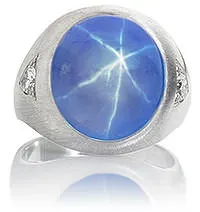 The Star
The Star ![]() sapphire variety does not have such intense blue color as the regular variety. Instead, it is bluish gray or even more milky-white than blue. The blue-gray, gray, and white sapphire stones show the star much more clearly because the lighter color has more inclusions that allow light to pass through. The star inside the Star sapphire is said to dance along the stone when the light bounces off it. This moving star is believed to safeguard against all forms of witchcraft.
sapphire variety does not have such intense blue color as the regular variety. Instead, it is bluish gray or even more milky-white than blue. The blue-gray, gray, and white sapphire stones show the star much more clearly because the lighter color has more inclusions that allow light to pass through. The star inside the Star sapphire is said to dance along the stone when the light bounces off it. This moving star is believed to safeguard against all forms of witchcraft.
Sir Richard Francis Burton, a great Oriental traveler of the 18th century, was known to have a large Star ![]() sapphire, called "Asteria,"" in his possession. He referred to it as his talisman, believing it served him as a guiding star, bringing him fine horses and proper attention wherever he went. In reality, he took his Star sapphire out to show the natives only after he got the proper attention he was seeking. The natives appreciated seeing this magnificent stone because they believed seeing it brought them good fortune. The sapphire's fame quickly spread well ahead Burton's travels, and the Germans even had a name for it ï¾– they called it ""Siegstein"", or victory stone."
sapphire, called "Asteria,"" in his possession. He referred to it as his talisman, believing it served him as a guiding star, bringing him fine horses and proper attention wherever he went. In reality, he took his Star sapphire out to show the natives only after he got the proper attention he was seeking. The natives appreciated seeing this magnificent stone because they believed seeing it brought them good fortune. The sapphire's fame quickly spread well ahead Burton's travels, and the Germans even had a name for it ï¾– they called it ""Siegstein"", or victory stone."
Another famous Asteria, known as the "Star of India"", weighs 543 karats. After wandering around for three centuries, it finally found a worthy resting-place in the American Museum of Natural History in New York City, as part of the Morgan-Tiffany collection. The three lines that run across this famous Star ![]() sapphire are thought to represent Hope, Faith, and Destiny, and because of that, the stone is sometimes called ""The Stone of Destiny."" As the stone is moved, or the light changes, a star appears in its center, warding off bad omens and the Evil Eye. Its powers are said to be so potent, that they continue working for its original owner even if the stone has been given to someone else."
sapphire are thought to represent Hope, Faith, and Destiny, and because of that, the stone is sometimes called ""The Stone of Destiny."" As the stone is moved, or the light changes, a star appears in its center, warding off bad omens and the Evil Eye. Its powers are said to be so potent, that they continue working for its original owner even if the stone has been given to someone else."
The ![]() sard was thought to safeguard its wearer against evil spells and sorcery. It would also sharpen the intellect of the wearer, rendering him daring, successful, and in high spirits. The red tint of the sard stone would counteract the harmful influence of the dark
sard was thought to safeguard its wearer against evil spells and sorcery. It would also sharpen the intellect of the wearer, rendering him daring, successful, and in high spirits. The red tint of the sard stone would counteract the harmful influence of the dark ![]() onyx, dispelling bad dreams and driving away melancholy feelings it inspired.
onyx, dispelling bad dreams and driving away melancholy feelings it inspired.
The Italian peasants have long held a belief that green serpentine pebbles would protect its owner from bites of venomous snakes. The serpentine is usually green with streaks of white, and its name is derived from its resemblance to a serpent's skin. In addition to preventing one from being bitten by snakes, the serpentine was believed to cure already existing poisonous bites by drawing out the venom when placed directly on the wound. However, the serpentine must be in its original form, and not shaped or crafted by man's hands. It was widely believed that a stone that was touched by an iron instrument, such as a jeweler's tool, would lose its magic properties.
The earliest mention of ![]() turquoise was in ancient Egypt. It was later referred by the Roman philosopher Pliny by the name of "callais."" turquoise was thought to protect the wearer from injuries related to falling, specifically from horseback riding, probably because it was believed to make the horse run faster and be less likely to stumble. Later, it was extended to include falls from a building or a cliff. The Lapidaire, a 14th-century French encyclopedia of gems and their qualities, explained that turquoise safeguarded the horses from the hazards of drinking cold water when overheated from exertion. turquoise was even referred to in the East as ""horse amulet"" and the Turks would often attach turquoise stones to their horses' bridles and frontlets for good luck. Since turquoise sports a blue color of the sky, and horses were regarded as a symbol of the sun as they run through heavens, and that was how horses became associated with turquoise."
turquoise was in ancient Egypt. It was later referred by the Roman philosopher Pliny by the name of "callais."" turquoise was thought to protect the wearer from injuries related to falling, specifically from horseback riding, probably because it was believed to make the horse run faster and be less likely to stumble. Later, it was extended to include falls from a building or a cliff. The Lapidaire, a 14th-century French encyclopedia of gems and their qualities, explained that turquoise safeguarded the horses from the hazards of drinking cold water when overheated from exertion. turquoise was even referred to in the East as ""horse amulet"" and the Turks would often attach turquoise stones to their horses' bridles and frontlets for good luck. Since turquoise sports a blue color of the sky, and horses were regarded as a symbol of the sun as they run through heavens, and that was how horses became associated with turquoise."
Anselmus de Boot, the court physician of Roman Emperor Rudolph II (1552-1612), recounts the story of how an old, lackluster ![]() turquoise gained back its magnificent color. There was an old turquoise stone for sale along with the rest of the owner's property. This turquoise stone was in possession of a certain Spaniard for nearly 30 years. Nevertheless, de Boot's father decided to purchase it for an insignificant sum. Having arrived home, he decided that the gem was too embarrassing to wear and chose to give it to his son, instead. He told him that turquoise's virtues are said to appear only when it is gifted, so he's going to test it out by giving it to his son. The recipient didn't think much of the gift and made it into a ring with his family's insignia engraved on it. He had barely worn it for a month when the turquoise's shine and splendor began to return. In fact, it grew more beautiful with each passing day.
turquoise gained back its magnificent color. There was an old turquoise stone for sale along with the rest of the owner's property. This turquoise stone was in possession of a certain Spaniard for nearly 30 years. Nevertheless, de Boot's father decided to purchase it for an insignificant sum. Having arrived home, he decided that the gem was too embarrassing to wear and chose to give it to his son, instead. He told him that turquoise's virtues are said to appear only when it is gifted, so he's going to test it out by giving it to his son. The recipient didn't think much of the gift and made it into a ring with his family's insignia engraved on it. He had barely worn it for a month when the turquoise's shine and splendor began to return. In fact, it grew more beautiful with each passing day.
Very soon after, the ![]() turquoise's virtues were put to the test. One night, as de Boot was returning to Bohemia from Padua, he was forced to cross a narrow and dangerous road in the darkness. Suddenly, his horse lost its balance and threw him to the ground. Miraculously, neither horse nor rider was injured in the fall, even though a quarter of his turquoise chipped away. The turquoise did not lose its power, though. Some time after, the owner was lifting a heavy pole when he heard his ribs crack, accompanied by a sharp pain at his side. He feared that he seriously injured himself, but it turned out that no bones were broken, and it was just a sprain. At that time, de Boot noticed that his turquoise cracked into two pieces.
turquoise's virtues were put to the test. One night, as de Boot was returning to Bohemia from Padua, he was forced to cross a narrow and dangerous road in the darkness. Suddenly, his horse lost its balance and threw him to the ground. Miraculously, neither horse nor rider was injured in the fall, even though a quarter of his turquoise chipped away. The turquoise did not lose its power, though. Some time after, the owner was lifting a heavy pole when he heard his ribs crack, accompanied by a sharp pain at his side. He feared that he seriously injured himself, but it turned out that no bones were broken, and it was just a sprain. At that time, de Boot noticed that his turquoise cracked into two pieces.
Another unusual virtue attributed to the ![]() turquoise was its supposed ability to tell time. It had to be suspended in the air by a string held between the thumb and the index finger, and any slight vibration would make the stone strike the appropriate number of times against a glass. De Boot maintains that he tested this theory numerous times; however, it was merely a subconscious effect of the mind on the body. The anticipation that the stone was expected to strike a certain number of times influenced the uncontrolled movement of the hand.
turquoise was its supposed ability to tell time. It had to be suspended in the air by a string held between the thumb and the index finger, and any slight vibration would make the stone strike the appropriate number of times against a glass. De Boot maintains that he tested this theory numerous times; however, it was merely a subconscious effect of the mind on the body. The anticipation that the stone was expected to strike a certain number of times influenced the uncontrolled movement of the hand.
![]() turquoise was extremely popular among the English at the beginning of the 17th century. In fact, it was exclusively worn by men. In 1609, de Boot wrote that no man would consider himself complete unless his hand sported a superior turquoise.
turquoise was extremely popular among the English at the beginning of the 17th century. In fact, it was exclusively worn by men. In 1609, de Boot wrote that no man would consider himself complete unless his hand sported a superior turquoise.
![]() turquoise was widely used in Samarkand and Persia. In fact, it was their national stone. The Persians believed that to attract good fortune and to drive away evil; one should see the image of the new moon either on a friend's face, on the holy Koran, or on a turquoise.
turquoise was widely used in Samarkand and Persia. In fact, it was their national stone. The Persians believed that to attract good fortune and to drive away evil; one should see the image of the new moon either on a friend's face, on the holy Koran, or on a turquoise.
The Pueblo Indians from New Mexico revered ![]() turquoise as well. They would make heart-shaped ornaments called Malacates out of the turquoise that they mined from the local Los Cerrillos mines. They expressed disapproval when the settlers tried to extract turquoise from their mines, believing that it is a sacred stone and should not come into possession of those who do not believe in their god Montezuma. An unusual object was uncovered in the ruins of Los Muertos, nine miles from Temple, Arizona. It was made out of a seashell, painted black, and encrusted with turquoise and Garnets in a mosaic made to resemble a toad, the Zuni Pueblo Indian sacred symbol.
turquoise as well. They would make heart-shaped ornaments called Malacates out of the turquoise that they mined from the local Los Cerrillos mines. They expressed disapproval when the settlers tried to extract turquoise from their mines, believing that it is a sacred stone and should not come into possession of those who do not believe in their god Montezuma. An unusual object was uncovered in the ruins of Los Muertos, nine miles from Temple, Arizona. It was made out of a seashell, painted black, and encrusted with turquoise and Garnets in a mosaic made to resemble a toad, the Zuni Pueblo Indian sacred symbol.
Mr. George H. Pepper is credited with unearthing the Pueblo Bonito burial grounds of the Chaco Canyon ruins, in the Northwestern part of New Mexico in 1896. One skeleton that was found had nearly nine thousand ![]() turquoise beads and pendants, showing the high rank of the buried individual and the importance of turquoise to him. Some of these beads were probably part of necklaces and anklets, and many others were used in pendants crafted in the shapes of a rabbit, a bird, an insect, a human foot, and a shoe. Those were supposed to attract the guardian spirit into the stone. Another skeleton in the same burial chamber boasted nearly six thousand turquoise beads and pendants. The total amount of turquoise beads collectively found in these graves was close to 24,932, a powerful testament to turquoise's power and popularity.
turquoise beads and pendants, showing the high rank of the buried individual and the importance of turquoise to him. Some of these beads were probably part of necklaces and anklets, and many others were used in pendants crafted in the shapes of a rabbit, a bird, an insect, a human foot, and a shoe. Those were supposed to attract the guardian spirit into the stone. Another skeleton in the same burial chamber boasted nearly six thousand turquoise beads and pendants. The total amount of turquoise beads collectively found in these graves was close to 24,932, a powerful testament to turquoise's power and popularity.
Another fascinating object found in the Pueblo Bonito burial grounds was a cylindrical basket encrusted with 1,214 pieces of ![]() turquoise. It probably had special ritual use and significance. The legends of the Navajo Indians contain references to "turquoise jewel baskets"", and Mr. Pepper thinks it may have referred to the turquoise baskets made by the Pueblo Indians."
turquoise. It probably had special ritual use and significance. The legends of the Navajo Indians contain references to "turquoise jewel baskets"", and Mr. Pepper thinks it may have referred to the turquoise baskets made by the Pueblo Indians."
 The Apache Indians named their
The Apache Indians named their ![]() turquoise "duklij"", which means a green or a blue stone. The turquoise was greatly prized and used for talismanic purposes. Possessing a turquoise was essential to a medicine-man, as he would not receive appropriate recognition without it. There was a belief that turquoise can be found by following a rainbow after a storm and searching in the damp earth. The special virtues attributed to turquoise by the Apache Indians were to help the warrior or hunter by improving the precision of his aim. If a gun or a bow had turquoise on it, the shot from the weapon would go straight to its target."
turquoise "duklij"", which means a green or a blue stone. The turquoise was greatly prized and used for talismanic purposes. Possessing a turquoise was essential to a medicine-man, as he would not receive appropriate recognition without it. There was a belief that turquoise can be found by following a rainbow after a storm and searching in the damp earth. The special virtues attributed to turquoise by the Apache Indians were to help the warrior or hunter by improving the precision of his aim. If a gun or a bow had turquoise on it, the shot from the weapon would go straight to its target."
 There once was a lady in London who was famous for restoring pale and tarnished
There once was a lady in London who was famous for restoring pale and tarnished ![]() turquoise stones to their original, vibrant hue. Many people whose turquoise has faded have used her services. The writer of this book believes that her power to restore turquoise was imaginary, but he does assert that the condition of a turquoise stone can very well depend on the general health of its owner and that just like eggs, once cooked, can never be restored back to their original state.
turquoise stones to their original, vibrant hue. Many people whose turquoise has faded have used her services. The writer of this book believes that her power to restore turquoise was imaginary, but he does assert that the condition of a turquoise stone can very well depend on the general health of its owner and that just like eggs, once cooked, can never be restored back to their original state.